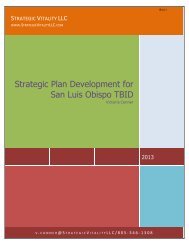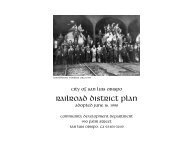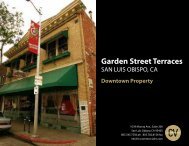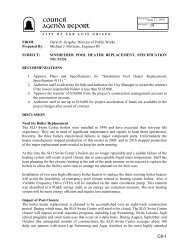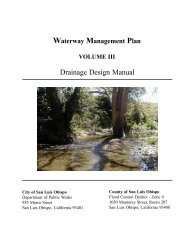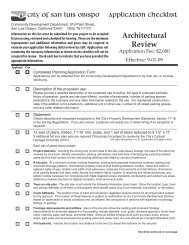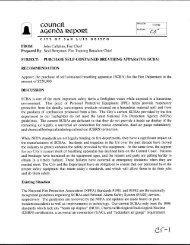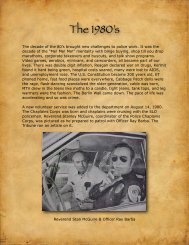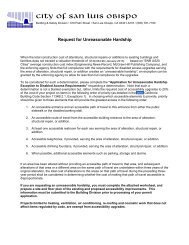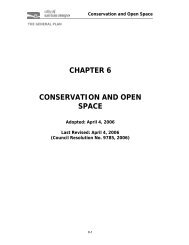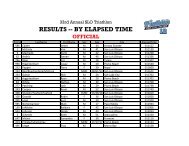South Broad Street Corridor Plan - the City of San Luis Obispo
South Broad Street Corridor Plan - the City of San Luis Obispo
South Broad Street Corridor Plan - the City of San Luis Obispo
You also want an ePaper? Increase the reach of your titles
YUMPU automatically turns print PDFs into web optimized ePapers that Google loves.
<strong>South</strong> <strong>Broad</strong> <strong>Street</strong> <strong>Corridor</strong> Area <strong>Plan</strong> – PC Hearing Draft February 2012<br />
4.5 SIGNAGE, STREET FURNITURE, AND SPECIAL PAVING<br />
Signage. Signage shall comply with <strong>the</strong> Sign Regulations, Ch. 15.40 <strong>of</strong> <strong>the</strong> <strong>San</strong> <strong>Luis</strong> <strong>Obispo</strong> Municipal<br />
Code.<br />
<strong>Street</strong> Furniture and Special Paving.<br />
(A) Kiosks serve as information booths and/or shelter for small vendors. Kiosk design should be<br />
consistent with <strong>the</strong> architectural style <strong>of</strong> surrounding buildings and any nearby landscaped frontages.<br />
(B) Newspaper racks should occur around major pedestrian ga<strong>the</strong>ring areas. The design should<br />
consolidate all vending boxes into one rack. Rack construction should use masonry elements or metal that<br />
complements o<strong>the</strong>r site furnishings in <strong>the</strong> area or <strong>the</strong> architecture <strong>of</strong> adjacent buildings. The rack should<br />
be attractive on all sides and properly anchored. Individual racks should not be permitted.<br />
(C) Bicycle racks shall be designed to meet <strong>the</strong> <strong>City</strong>’s Bicycle Facilities <strong>Plan</strong>, and should be located and<br />
sized according to <strong>the</strong> Community Design Guidelines Chapter 6.3.F. The color <strong>of</strong> bicycle racks should<br />
coordinate with <strong>the</strong> color scheme established for all <strong>of</strong> <strong>the</strong> street furnishings.<br />
(D) Throughout <strong>the</strong> Area <strong>Plan</strong>, solid waste and recycling receptacles should be provided. Receptacles<br />
should have vertical metal bars and be painted to match o<strong>the</strong>r recommended features. To avoid overflow,<br />
receptacles should be sized to be at least a thirty-gallon capacity, especially in commercial areas, and<br />
should be properly anchored. Multiple coats <strong>of</strong> a powder coating or comparable finish are recommended<br />
for durability.<br />
(E) <strong>Plan</strong>ters should be simple in form. Round and square types are recommended. <strong>Plan</strong>ter material should<br />
be durable and attractive. <strong>Plan</strong>ters should be at least three (3) feet in diameter. <strong>Plan</strong>ters <strong>of</strong> various sizes<br />
should be grouped in clusters to enrich streetscapes and plazas.<br />
(F) Paving, plants, and site furnishings should be utilized to enhance <strong>the</strong> character <strong>of</strong> <strong>the</strong> plan area. These<br />
features should be consistent with <strong>the</strong> following recommendations, whe<strong>the</strong>r in streets, parks, or plazas, or<br />
as on-site landscaping:<br />
1. Interlocking pavers or equal shall be used in <strong>the</strong> public realm for plazas, Village Courts, pedestrian<br />
arcades, and pass-throughs, and in crosswalks on all streets within <strong>the</strong> planning area. Pavers should be<br />
durable and <strong>of</strong> brick, stone, or o<strong>the</strong>r materials appropriate to <strong>the</strong> area’s architectural character.<br />
2. Alternative paving methods can be used to locally infiltrate rainwater and <strong>the</strong> run<strong>of</strong>f leaving a site.<br />
Examples <strong>of</strong> such methods include interlocking concrete pavers and grass pavers. These methods<br />
provide a solid ground surface, strong enough to manage heavy, frequent loads, while at <strong>the</strong> same<br />
time allowing water to filter through <strong>the</strong> surface and reach <strong>the</strong><br />
underlying soils.<br />
Figure 4.9 Examples <strong>of</strong> Alternative Paving Methods<br />
60



